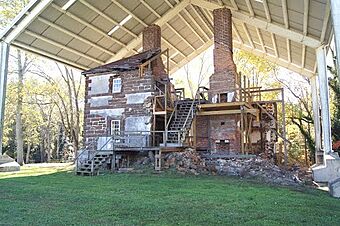Menokin facts for kids
|
Menokin
|
|

The plantation in 2014
|
|
| Location | NW of jct. of Rtes. 690 and 621, near Warsaw, Virginia |
|---|---|
| Area | 590 acres (240 ha) |
| Built | 1769 |
| Architect | John Ariss |
| Architectural style | Georgian |
| NRHP reference No. | 69000276 |
Quick facts for kids Significant dates |
|
| Added to NRHP | October 1, 1969 |
| Designated NHL | November 11, 1971 |
Menokin, also known as the Francis Lightfoot Lee House, was a large farm called a plantation. It belonged to Francis Lightfoot Lee near Warsaw, Virginia. His wife's father, Col. John Tayloe II, built it for them. Lee was one of America's Founding Fathers. He signed the United States Declaration of Independence, a very important document. Menokin was named a National Historic Landmark in 1971. This means it's a special place in American history.
Today, the house is partly in ruins. However, the Menokin Foundation has an exciting plan. They are restoring the house using clear glass to fill in the missing walls and roof. This way, visitors can see the original structure and how it once looked.
Contents
Ancient History of Menokin's Land
Long before Menokin was built, the Rappahannock Indian Tribe lived here. This area is along Cat Point Creek, which flows into the Rappahannock River. In 1608, Captain John Smith explored these creeks. He wrote about meeting the Rappahannocks. This gives us a look into the lives of the people who lived here then.
The Rappahannocks called this land "Menokin." We don't know what the word means today. Francis Lightfoot Lee liked the name and kept it for his new home.
Building Menokin and Its Journey Through Time
Menokin was built around 1769. It was a wedding gift for Francis Lightfoot Lee and Rebecca Tayloe. Rebecca's father, John Tayloe II, owned the nearby Mount Airy. He gave the couple this large farm on Cat Point Creek. He also paid for the two-story stone house and other buildings.
Soon after, Francis Lightfoot Lee became involved in the fight for American independence. He served in the Continental Congress from 1775 to 1779. He signed the Declaration of Independence, along with his brother Richard Henry Lee. He also signed the Articles of Confederation, which was America's first set of rules.
Francis Lightfoot and Rebecca Tayloe Lee both passed away in 1797. Menokin then belonged to Rebecca's nephew, John Tayloe III. The house changed owners many times over the years. By 1935, it was mostly empty and falling apart. In 1995, The Menokin Foundation took over the property. They began working to save this historic place.
Francis Lightfoot Lee: A Founding Father
Francis Lightfoot Lee played a big role in Virginia and the early United States. He was one of the people who helped create our country. We learn about him from his letters and what friends said. He signed important documents like the Westmoreland Resolves in 1766. He also signed the Declaration of Independence in 1776.
Lee served in Virginia's government and in the Continental Congress. After 1779, he mostly enjoyed life at Menokin. He loved his books, his farm, and his wife, Becky Tayloe. The Menokin Foundation continues to learn more about his life and work.
Menokin's Unique Architectural Story
Even though Menokin is now a ruin, many original parts remain. About 80 percent of the house's first materials have survived. This includes stones, bricks, and even parts of the wooden frame. In 1940, detailed photos and drawings were made of the house. These help us understand its original design.
In 1964, the original drawings for Menokin were found. They were in the attic of Mount Airy. A few years later, the house was in danger of collapsing. So, the beautiful interior woodwork was carefully removed and stored. This woodwork is now back at Menokin. You can see it at the Foundation's King Conservation and Visitors Center.
In 2014, the Menokin Foundation started a big project. They are replacing the missing walls and roof with strong, clear glass. This allows visitors to see the original stone walls and the surrounding nature at the same time. This project was finished in 2024.
In 2018, the Menokin Foundation built the Remembrance Structure. This building honors the enslaved people who lived and worked at Menokin. It uses modern, see-through siding. This makes the structure glow, serving as a beautiful memorial.
Key Moments in Menokin's History
- 1734: Francis Lightfoot Lee is born.
- 1751: John Tayloe II gets the Menokin land.
- 1766: Francis Lee signs the Westmoreland Resolves.
- 1769: Francis Lee marries Rebecca Tayloe. Menokin plantation is a wedding gift.
- 1769: Construction of the Menokin mansion begins.
- 1771: Francis and Rebecca Lee move into Menokin.
- 1775-1779: Francis Lee is a member of the Continental Congress.
- 1776: Francis Lee signs the Declaration of Independence.
- 1797: Francis and Rebecca Lee pass away.
- 1968: Menokin is added to the Virginia Landmarks Register.
- 1971: Menokin is named a National Historic Landmark.
- 1995: The Menokin Foundation receives the mansion and land.
- 2004: The Martin Kirwan King Conservation and Visitors Center opens.
- 2015: The Glass House Project begins.
- 2018: The Menokin Remembrance Structure is completed.
See also



